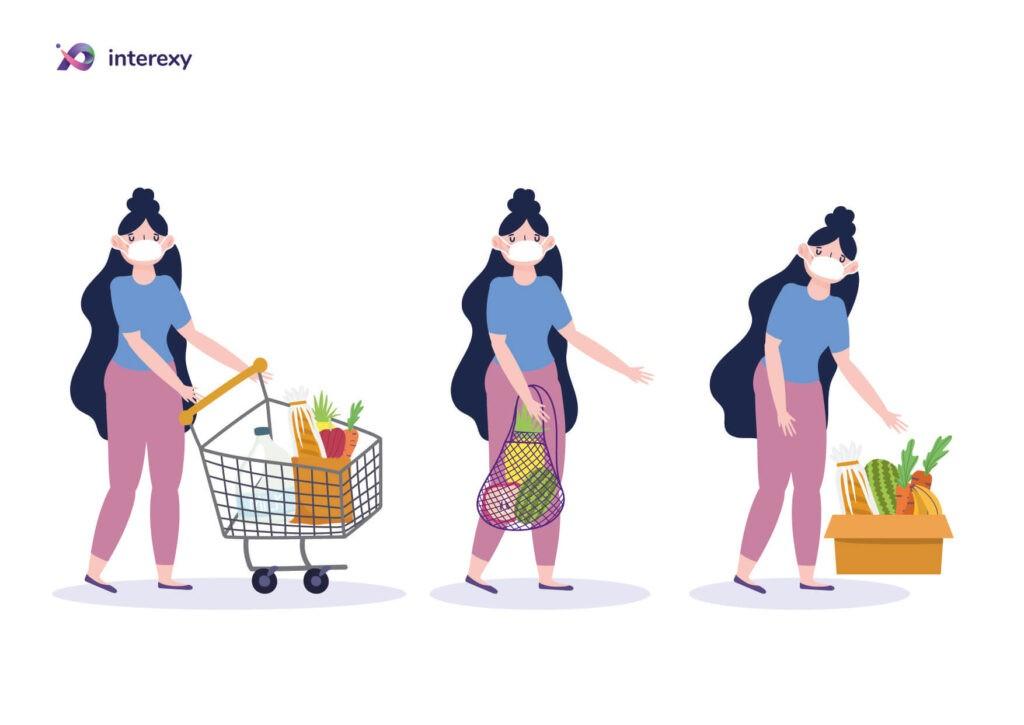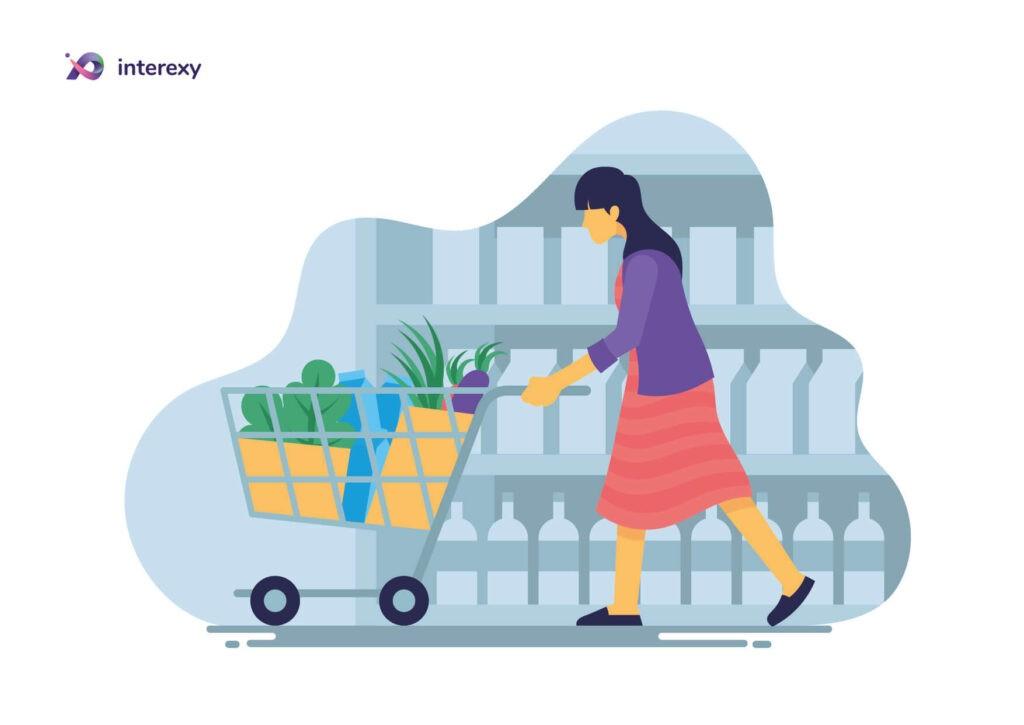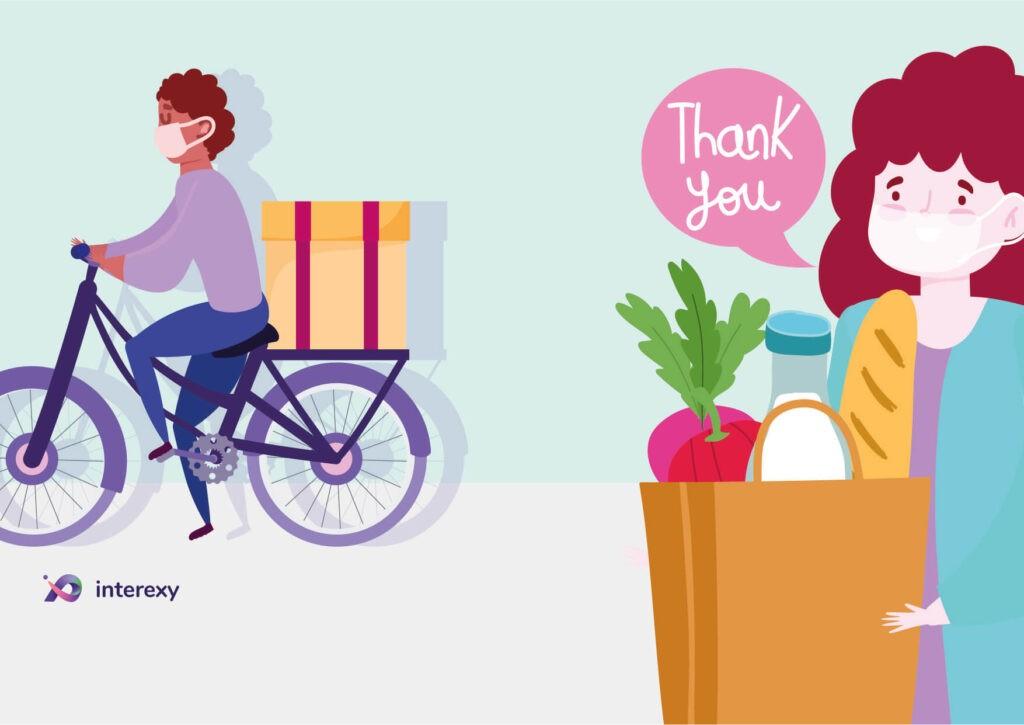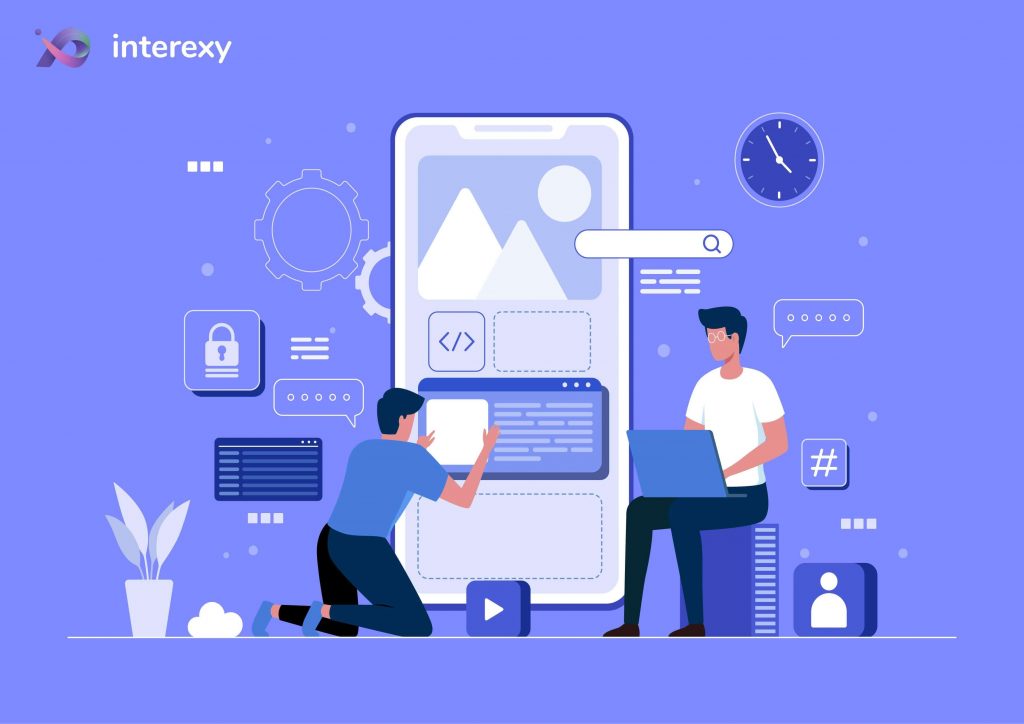September 30, 2021
How to Create a Grocery Delivery Application: Guide on Grocery Delivery App Development
Table of content

In the modern area we live in, everything can be done by tapping on our phones. The digital sphere boomed years ago and significantly eased many vital spheres of our lives. The same happened to the delivery industry, as now people prefer to shop online rather than go out to the physical stores.
After COVID-19 and the global pandemic, the number of smartphones usages for prepared food, alcoholic, and grocery delivery increased up to 3 times. This is because people now can’t freely go to the shop and get what they need without worries of catching the virus.The main shift in app development was in the USA, Canada, and Europe, as these parts of the world still remain in isolation.
According to a CNBC report, the food delivery market is growing at a rapid pace in the upcoming five years, while the delivery service will become mandatory for both online and offline stores. This means this is a great time to consider app development, as they either will have to launch their food delivery services or connect to the relevant aggregator to stay on-demand and not to fail at this challenging time. Keeping that in mind, we developed this guide to show you how to build a grocery delivery app and succeed in this space.
Types of grocery delivery app solution
While there are numerous applications for grocery delivery, only a few of them gained in popularity and were able to attract customers. When building a grocery delivery app, it is vital to understand what type of app you want and what problem it will solve. There are several types of grocery apps, including aggregators, marketplaces, and single stores, grocery chains, or personalized grocery apps. Now let’s take a closer look at the most prominent online services for delivery.
Instacart
We will start the list with one of today’s leaders in the online grocery space in North America. The app covers almost 85% of the US and up to 65% of Canadian residents. Instacart is a delivery type of application that has tie-ups with world giants like WholeFoods, Costco, Safeway, and others and delivers products from their local stores. The mechanism of action is straightforward, as users can get everything they need from an application they have and choose grocery available in multiple stores. It also allows consumers to compare prices and purchase products at the best prices. Instacart was valued at $8 billion in 2019.
Postmates
The second on-demand grocery delivery app solution is Postmates. It represents a tech-driven courier service designed for users’ daily needs. The service uses mobile devices with GPS to cater to all customers’ preferences based on nearby products and deliver items to you. The brand also partnered with McDonald’s, Walgreens, Starbucks, Chipotle, etc., and processed over 8 million orders last month. The application has around 250,000 merchants serving approximately 3500 cities. Today, the company is estimated at US$1.85 billion.
Shipt
This grocery-delivery service operates within all US states. It has gained more than 50,000 customers and annual revenue of $120 million. The brand is partnered with retailers like Whole Foods, Target, Publix, Costco, etc. Shipt is a go-to application since it offers numerous features that no other app offers. Its specially developed business model provides users with the ability to check out what’s on sale and allows requests for products that are not listed on the stores in the app. The app monetized money from subscriptions, providing a monthly fee of $ 15 or a yearly membership fee of $99.
Peapod
Peapod is a grocery delivery business founded in Chicago. Although it was first focused on Chicago only, now the business has expanded among Washington, Boston, New York, Virginia, Indiana, Illinois, and Chicago. The application allows users to create lists, repeat purchases and even track frequent purchases to allow them to then repeat a purchase.
The app was powered by a well-thought-out algorithm that understands the customers and offers them filtered results based on their needs. Another outstanding feature that the app provides is ordering all required products for a meal kit they want.

Essential Features of Grocery Delivery App
Easy signup process
The key step in any grocery delivery application development is to make sure your users get a great first impression. The sign-in feature should be as easy as possible and allows users to get through the registration process with fun and enjoyment. Making a signup process easier will lead customers towards without any negative thoughts and leave the first impression of everything the app does.
You should also make sure you provide many options for the registration. Therefore, it is advisable to include a possibility to sign using google, Facebook, or other popular websites.
Enhanced search
Developing a grocery delivery app is a complex service. And since such delivery applications provide hundreds of products, it could be challenging for some users to find and choose the needed product by using the enhanced search option. This feature is essential and should be as variable as possible. You should ensure you give users a quick list of items that can be used in the household while also providing mostly sold/searched products via a history.

Provide a cart option
Once a customer gets through the whole shopping process, he wants to enter the cart option to finalize the purchasing. When considering how to make a grocery delivery app, ensure you provide an “add to cart” feature behind every product to make customers feel safe that everything has been added and nothing will be missed. It should also work just by tapping, making a regular shopping experience when they add items to their trolley.
Add Recommendation
This feature is also a must-have when you create grocery delivery app. This is because providing recommendations based either on similar products or previous orders can significantly boost your orders and overall revenue. This feature also is highly convenient for users, as it can save time for them choosing, for instance other vegan-friendly

Payment options
Another vital feature you should consider when thinking about how to develop a grocery delivery app. Payment options should be different and provided according to the target audience. make sure you allow users to pay by credit card, apple pay, cash, or any other options that are most popular in the area you deliver in.
Steps in Building Grocery Delivery App
Concept and objective
The first step in grocery delivery app development is creating a concept and analyzing the objective of the final project. Here you need to think about a target audience, the type of app you want, what problem the app will solve, and in what way. Through this step, you will also come up with the required technology stack, understand the time needed and human resources to build the product from scratch. At this stage, you can learn from competitors better and find non-obvious solutions that may put your applications above all others.
Wireframes and prototypes
Once the first stage is done and you have already created a roadmap for the project, it is time to consider the UX/UI design. Since you analyzed product requirements, target audience, and pain points, you can efficiently create user flows and stories. Through designing wireframes and prototypes, you will be able to build the visual side of a mobile app and later check where you want to change something before the development stage. It is vital to polish it until you’re delighted and every feature is well-thought-out.
Development
Everything that has been illustrated by your UI/UX team then should be translated into reality during the iterative development process. Through this stage, your developers will develop every part of the app’s functionality that the QA team will then test. Here you should make sure that everything is well established, your main features work as you wanted, and the final product will solve the main pain points you established at the first stage of development.
Testing
Once everything is done, almost the last stage of development of your grocery application is testing. This part should be performed by your QA team and check the app during the following stages;
- Unit testing;
- Integration testing;
- System testing;
- Acceptance testing.

Launching
The final stage of building grocery delivery app is maintenance and launching. After you check the app and ensure it works the way you want it, you need to launch it on the chosen marketplace. If your app has been developed according to certain rules listed by Apple or Google play, it won’t take a lot of time to launch your app. After it is done, you should also get feedback from users and see what they like most about your application and check what the problems are. If this happens, ask your developers to get back to the development and resolve all problems. After all, you should also remember to update the app after a few months to stay on demand.
Consider Interexy Your Trusted Partner
Interexy always stays informed about the latest technology achievements to develop the highest-quality applications. During our journey, we were a trusted partner for Tinga Nutrition Inc. is – a Canada-based startup that was founded by Robert Fedun and his partners.
Once we collected every feature our client wanted us to follow, we created a team of dedicated developers with relevant experience and strong backgrounds. We delivered a top-notch mobile application that allows users to create their own profiles and get through all products they usually see on the shells at local stores.
We also offer users to check each item for energy value, as filters available in the app help them to avoid unwanted products that may cause allergies, intolerance, or eliminate animal-based products in their search. Although it was challenging to import recipes from allrecipe.com and bbcgoodfood.com on our platform, we successfully overcame this problem within a few weeks, and now the app contains everything customers need to cook dishes with the best guides available at the market.
If you are stopped here and don’t think you are ready to find great developers and designers to create a grocery ordering delivery app that will boom the market, reach us out and trust our dedicated team with your craziest ideas!
Final thoughts
We crafted this article to help you easily get through the hardest questions of building a great grocery delivery application. Here we explained what to focus on when starting developing, the main features you need to include in the app, and the stages involved in the process. Interexy has solid experience in developing apps intended for various industries, including grocery delivery. Contact our team, and let’s build create a grocery shopping delivery app that will take the market by storm and help you overcome all competitors.
FAQs
Why is it better to hire grocery delivery app development company?
When you want to develop a grocery delivery app, you will come up with a question to either hire every specialist one by one or find the whole development company. The statistics show that it is better to hire a whole team that has already worked in the same industry and works in unison. In addition, you will save money and time, as searching for low-cost specialists for your project requires a lot of resources you won’t need to waste.
Is it worth to start grocery delivery service?
Although the COVID is slowly getting down, people are now much more into digital solutions than ever before, and experts say it won’t change in upcoming years. No matter whether you have a grocery shop or just want to start your own business, the app development will bring your startup to success in the market and help you get great revenue within a few months.
In addition, the food delivery app industry is steadily growing with no signs of slowing down in the near future. According to statistics, the industry projected an annual growth rate of 6.4% in the Online Food Delivery sector. The report shows these numbers will reach $151 million by the end of 2020.
How much does it cost to develop a food delivery app like uber eats?
If you consider freelance developers, you will need to pay by hours for every team member. Think about the following amounts:
- In the USA, building a food delivery app like uber eats is usually cost between $50 and $250 per hour;
- One developer in Europe can cost between US$ 30 and US$ 150 per hour for building a food ordering system pricing service;
- Finally, In India, the cost of building such an application will cost you between US$10 and US$80 per hour.
This is because hiring a team is much cheaper, and you can reach us out to estimate your project and compare.
What type of grocery delivery app should I choose?
We mentioned that there are several types of grocery delivery applications, like aggregators, marketplaces, and single stores, grocery chains, or personalized grocery apps. Your choice will depend on your current situation. So if you have a psychical store, you can opt for a personalized grocery app, but if you are just starting and want to successfully enter the market – the best idea is to create either marketplace or grocery chain application.
















